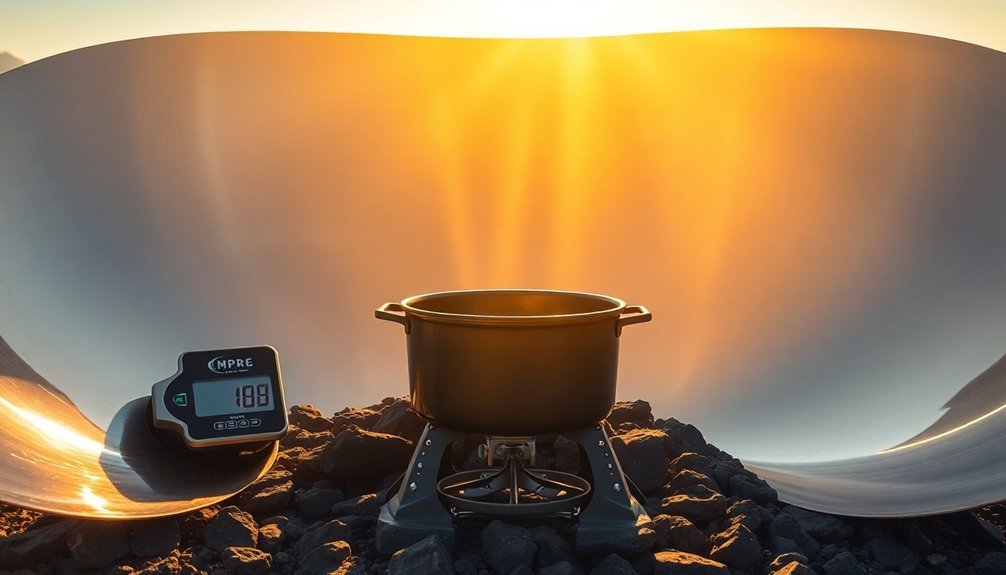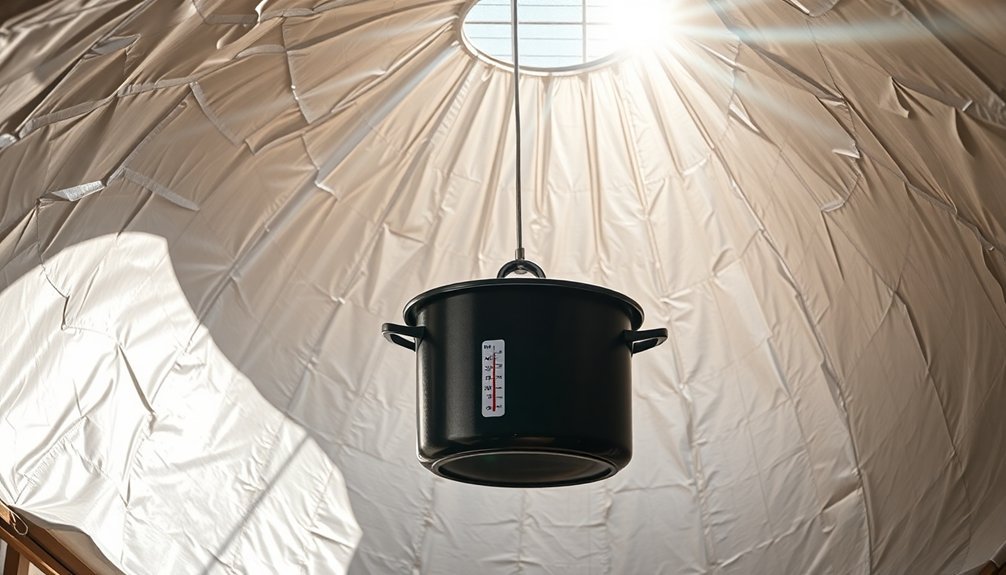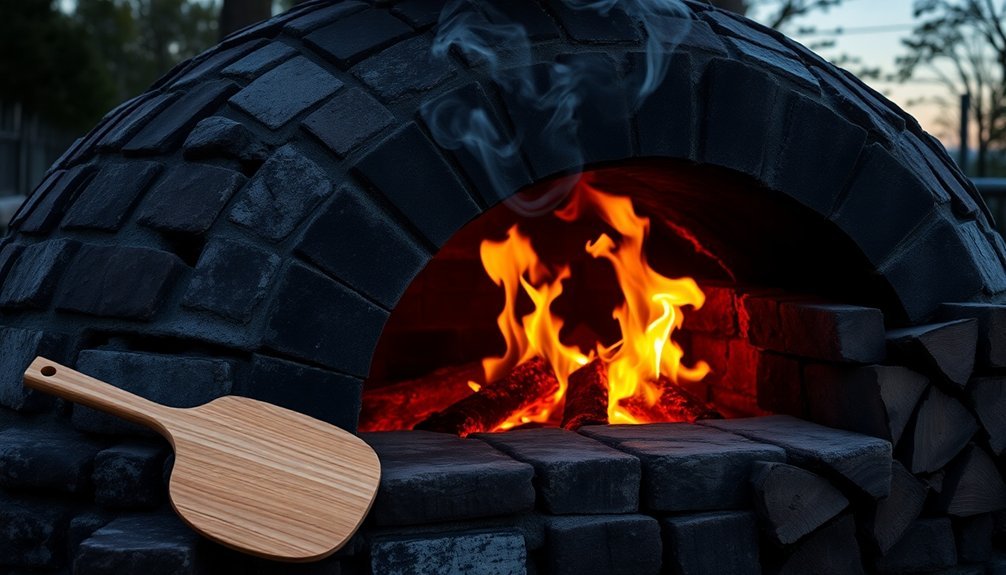Your seasonal sun-powered cooking journey adapts seamlessly with nature's calendar. In winter months, you'll focus on hearty stews and roasted vegetables between 10:30 AM and mid-afternoon, while summer opens up longer cooking windows from 10 AM to 2 PM with temperatures exceeding 200°F. Dark cookware and proper positioning maximize your solar oven's potential, reaching up to 325°F even on cooler days. You can cook multiple dishes simultaneously by planning around peak sunlight hours and using seasonal ingredients like winter squash or summer tomatoes. Each month brings unique opportunities to harness the sun's energy for your culinary adventures.
January: Hearty Winter Sun Feasts

While winter may seem like an unlikely time for solar cooking, January offers unique opportunities to harness the sun's power for hearty, warming meals.
You'll find the clearest sunlight between 10:30 AM and mid-afternoon, making it perfect for slow-cooked comfort foods.
Position your solar cooker to catch the lower winter sun angles, and you can create delicious dishes like roasted turkey, warming stews, and homestyle casseroles. A well-designed solar box cooker will work effectively even in freezing temperatures.
If you're using a parabolic cooker, you'll need to adjust it more frequently as the sun moves across the winter sky.
For best results, choose recipes featuring seasonal storage vegetables like carrots, potatoes, and squash.
Don't let limited daylight discourage you – you can always cook dishes in stages, completing them the next day if needed.
Your January solar meals can be just as satisfying as summer ones.
February: Comfort Foods From Above
As winter's chill lingers through February, solar cooking offers the ideal way to create heartwarming comfort foods that nourish both body and soul.
You'll find abundant seasonal ingredients like butternut squash, citrus fruits, and Brussels sprouts perfect for solar cooking between 9 a.m. and 3 p.m. Using a black pot in your solar oven, you can transform these ingredients into mood-boosting meals while harnessing the sun's energy.
- Try solar-baked mini turkey meatloaves with purple potatoes for a protein-rich comfort dish.
- Create a warming poblano chorizo chili that releases feel-good serotonin.
- Indulge in individual chocolate lava cakes that satisfy your sweet cravings guilt-free.
Remember to redirect your solar oven hourly for ideal results, and you'll enjoy the perfect blend of seasonal ingredients and sun-powered comfort. The roasting and stewing techniques common in February recipes work perfectly with solar cooking methods.
March: Early Spring Solar Delights

Spring's arrival in March brings longer days and stronger sunlight, making it the perfect time to expand your solar cooking repertoire.
Even on 45-degree days, you'll find success cooking between 10 a.m. and 2 p.m. when the sun reaches its peak.
Start with hearty bean dishes by soaking them overnight, then combining with diced onions and olive oil for a 6-hour solar cook. Using dark-colored pots will significantly improve your cooking results.
For quicker meals, try sautéing vegetables like mushrooms and celery, which take just 30-60 minutes. You can also experiment with fruit desserts or orzo salads.
Remember to preheat your solar oven to 300°F and adjust it frequently to track the sun's position.
Keep your reflector panels ready to maintain steady temperatures, and make certain you've got at least 20 minutes of sunshine per hour for food safety.
April: Fresh Seasonal Sun Cooking
April's garden bounty gives solar cooking enthusiasts even more options to explore.
You'll find an abundance of fresh produce like broccoli with its tight florets, crisp celery, and tender asparagus perfect for solar cooking.
Position your solar oven to capture maximum sunlight, and you can create nutritious springtime meals while harnessing sustainable energy.
- Try a sheet pan combination of seasonal vegetables like radishes and asparagus with lemon butter and sausage
- Create a vibrant double pea and burrata platter that showcases April's freshest ingredients
- Experiment with creamy polenta topped with spring vegetables and zesty gremolata
As you cook, remember to monitor temperatures and cooking times carefully.
You're not just preparing meals – you're participating in an eco-friendly cooking method that demonstrates the power of renewable energy.
May: Blooming Garden Solar Dishes

When May's warmer temperatures arrive, your solar cooking options expand dramatically with an abundance of fresh ingredients.
You'll find potatoes, sweet potatoes, and radishes ready for harvest, along with various leafy greens perfect for solar cooking.
Set up your solar oven 30 minutes before cooking, using dark-colored pans to maximize heat absorption.
You can create delicious dishes like roasted sweet potatoes with paprika and thyme, or shrimp skewers with fresh herbs.
For a complete meal, try a solar-baked beef roast surrounded by seasonal vegetables.
Don't forget to position your cooker to capture ideal sunlight and adjust reflectors as needed.
Whether you're using a panel cooker for rice dishes or a parabolic cooker for grilling vegetables, you'll discover that May's sunshine offers perfect conditions for sustainable, energy-efficient cooking.
June: Summer Solstice Kitchen Magic
When you're planning your summer solstice menu, take advantage of the year's longest daylight hours to grill peaches, corn, and fresh vegetables at their peak ripeness.
You'll find abundant seasonal ingredients like heirloom tomatoes, strawberries, and fresh herbs that can transform simple dishes into vibrant solstice celebrations.
Make the most of nature's timing by preparing sun-inspired dishes like Parmesan yellow squash and honey-based desserts during the extended evening light.
Peak Sunlight Cooking Tips
The summer solstice brings unparalleled opportunities to harness the sun's energy for eco-friendly cooking. You'll get the most out of solar cooking by scheduling your meal prep during peak daylight hours when the sun's rays are strongest.
Whether you're using a solar oven or water heater, you can prepare diverse dishes while reducing your energy consumption.
- Set up your solar cooker early in the day, positioning it to capture maximum sunlight with reflectors or aluminum foil-lined surfaces.
- Use solar-heated water for boiling, steaming, and other cooking methods that require hot liquids.
- Create an outdoor cooking station with solar-powered lighting and appliances to make the most of natural energy while enjoying the summer atmosphere.
Use these peak hours to preserve summer produce through pickling, drying, and fermenting methods.
Fresh Summer Menu Ideas
Celebrating summer solstice through food brings endless possibilities for fresh, vibrant dishes that capture the season's energy.
You'll find inspiration in nature's bounty, from grilled peaches paired with creamy burrata to bright heirloom tomato salads bursting with color.
Fire up your grill for lemon honey dijon chicken and corn with cilantro lime butter, or try convenient hobo foil packs for easy cleanup.
Create invigorating sides like watermelon radish salad or classic caprese with sun-ripened tomatoes.
Don't forget traditional elements – serve a honey cake for sweet renewal or prepare a cooling midsummer borscht.
For casual entertaining, set up a fajita station with grilled vegetables, or keep it simple with fresh BLTs.
Cool down with homemade popsicles or raspberry coconut mango sorbet – perfect treats for long, sun-filled days.
Optimal Solar Time Planning
Making the most of summer's abundant sunlight opens up exciting possibilities for solar cooking during the solstice season.
You'll find peak cooking hours between 8:30 AM and 6:30 PM, giving you plenty of time to prepare sun-powered meals. Position your cooker in direct sunlight and check for a UV index of 7 or higher for ideal results.
- Start early in the morning to maximize cooking time, adjusting your cooker every 1-2 hours to track the sun's path.
- Choose clear, cloudless days when temperatures can reach up to 325°F in your solar oven.
- Plan your menu around the sun's schedule, with longer-cooking dishes started earlier and quick-cooking items saved for midday.
Remember to maintain a backup cooking method for unexpected weather changes, ensuring you won't be caught off guard.
July: Peak Solar Cooking Season

You'll discover July's intense sunlight and extended daylight hours create ideal conditions for eco-friendly solar cooking, with peak temperatures reaching well over 200°F between 10 a.m. and 2 p.m.
Your solar cooker, whether it's a simple panel design or advanced parabolic model, can handle everything from slow-cooked stews to quickly grilled vegetables during this prime summer month.
Taking advantage of these ideal conditions, you can prepare fresh seasonal ingredients like tomatoes, zucchini, and herbs while saving energy and keeping your kitchen cool.
Maximizing Summer Sun Power
When July's intense sunlight reaches its peak, solar cooking becomes a sustainable and cost-effective way to prepare meals. You'll achieve the best results by choosing a design that matches your cooking needs, whether it's a simple pizza box oven or a sophisticated parabolic cooker.
To maximize your solar cooking efficiency during peak summer months:
- Position your cooker in direct sunlight and adjust it every 30 minutes to follow the sun's path.
- Use multiple reflective surfaces, like aluminum foil, to concentrate sunlight onto your cooking chamber.
- Create a well-insulated environment with clear plastic wrap and newspaper layers to trap heat.
Remember to preheat your solar oven for 15-30 minutes before cooking, and keep a thermometer handy to monitor internal temperatures, which can reach up to 200°F during ideal conditions.
Fresh Seasonal Recipe Ideas
July's abundant harvest pairs perfectly with solar cooking techniques to create memorable summer meals.
You'll find endless possibilities with peak-season vegetables like zucchini, bell peppers, and eggplant, which roast beautifully in your solar cooker's dark, heat-absorbing pots.
Try layering fresh corn and beans with tortillas in a Cheesy Green-Chile Chicken Casserole, ensuring your dish reaches 165°F for food safety.
For a lighter option, toss stone fruits like peaches and plums with fresh herbs in a sun-warmed salad.
Don't forget to preheat your solar cooker for 15-30 minutes before adding ingredients, and adjust your reflectors throughout cooking to maintain ideal temperature.
When working with seafood, monitor cooking times carefully – fresh shrimp and fish cook quickly in the intense summer sun.
August: Abundant Harvest Solar Meals
August's peak sun intensity creates perfect conditions for solar cooking, offering extended daylight hours from 11:00 AM to 3:00 PM.
You'll find these longer sun exposure times require less frequent repositioning of your solar cooker, making it ideal for preparing slow-cooked dishes and seasonal harvests.
Take advantage of the consistent temperatures between 100°C to 180°C to create flavorful meals using summer's bounty:
- Try a Moroccan Chickpea Tagine with fresh carrots and aromatic spices, letting it simmer for three hours in your solar oven.
- Cook perfect rice and grain dishes by maintaining proper water ratios under the steady heat.
- Transform seasonal fruits into delicious desserts by slow-cooking them with sugar and spices.
For best results, position your cooker directly facing the sun and start preheating as early as 10:00 AM.
September: Golden Autumn Sun Recipes

September's golden sunlight offers perfect conditions to harness solar cooking while celebrating autumn's bounty.
You'll find that seasonal ingredients like butternut squash, onions, and apples work beautifully in your solar oven, creating everything from caramelized onion toppings to warm fruit desserts.
Your solar cooking adventures can continue well into fall with hearty dishes like roasted vegetables and seasonal soups that make the most of harvest ingredients.
Autumn Solar Cooking Basics
As the vibrant autumn sun maintains its steady warmth, solar cooking offers an eco-friendly way to prepare seasonal dishes while harnessing nature's free energy.
You'll need a double-box design with insulation and a glass cover to trap heat effectively. Paint the interior black and add reflectors to maximize sun absorption. For best results, cook between 10 am and 4 pm using dark-colored cookware.
- Quick-cooking items (2 hours):
- White rice and egg dishes
- Fish fillets
- Fresh green vegetables
- Medium-duration foods (3 hours):
- Cornbread and gingerbread
- Medium-sized roasts
- All-day cooking options:
- Beans and lentils
- Root vegetables
Remember to rotate your cooker every 30-60 minutes and adjust the top inclination based on your latitude for ideal cooking results.
Harvest-to-Table Solar Recipes
The golden autumn sun creates perfect conditions for crafting delicious harvest-inspired solar recipes.
You'll want to gather seasonal vegetables like zucchini and pumpkin, along with fresh herbs such as dill and rosemary. Start by sautéing your vegetables in olive oil until they're slightly tender, then season them with white truffle salt and black pepper.
Position your solar cooker between 11:00 am and 3:00 pm for best results. You can use a box-type or parabolic oven, maintaining a temperature of around 160°C.
Don't forget to prepare a watercress and peanut pesto as your base layer. Once cooked, enhance your dish with Parmesan flakes, sliced almonds, and a drizzle of aromatic almond oil.
Serve your creation warm in a rustic, sun-shaped presentation that celebrates autumn's bounty.
October: Fall Colors Solar Menu
During October's crisp autumn days, you'll find solar cooking requires strategic timing and seasonal ingredients to create delicious fall-inspired meals.
Take advantage of prime cooking hours between 11:00 am and 3:00 pm, when the sun's position is ideal for your solar cooker. You can start preheating as early as 10:00 am to maximize your cooking window.
- Make the most of seasonal produce like apples, broccoli, and carrots in hearty dishes such as Moroccan Chickpea Tagine or Basque Chicken.
- Use well-insulated solar cookers to maintain heat during cooler fall temperatures.
- Plan your meals around shorter daylight hours by breaking up cooking into stages or preparing ingredients the day before.
Don't let autumn's shorter days discourage you – with proper timing and seasonal ingredients, you'll create wonderful solar-cooked meals.
November: Thanksgiving Solar Feast Planning

Moving from October's solar cooking strategies, November brings the exciting challenge of planning a memorable Thanksgiving feast using solar power.
You'll need to start by creating a detailed schedule that guarantees all dishes come together perfectly. Get a head start by gathering recipes and completing prep work days in advance.
For your main course, choose a 12.5 lb turkey or 4-6 lb turkey breast that'll fit in your solar oven. Using an oven cooking bag, you can achieve ideal results at temperatures up to 320°F.
While your turkey cooks for 3-4 hours, you can prepare traditional sides like cranberry sauce and sweet potatoes in the solar oven.
Don't forget to monitor weather conditions and adjust your oven's position throughout the day to maximize sunlight exposure.
December: Winter Holiday Solar Dishes
Winter holiday cooking goes solar with surprising efficiency, even in December's chilly temperatures. Your solar cooker can actually perform better in winter's clear skies, where less humidity means more direct sunlight.
Plus, snow reflection can boost your cooking power considerably.
For ideal holiday meal preparation in your solar cooker:
- Store your cooker indoors and preheat it by a south-facing window before taking it outside
- Monitor your dishes through steam observation rather than opening the lid unnecessarily
- Position your cooker to maximize both direct sunlight and snow reflection for enhanced performance
You'll find that even at temperatures below 10°F, you can prepare festive dishes effectively.
Just remember to adjust the cooker more frequently to track the winter sun's path, and you'll achieve delicious results despite the cold.
Frequently Asked Questions
Can Solar Cooking Work Effectively in Cold Climates With Limited Sunlight?
Yes, you'll find solar cooking works in cold climates if there's bright sunlight. Your success depends on clear skies, not temperature. You'll need longer cooking times and frequent adjustments during winter's limited daylight hours.
What Safety Precautions Should I Take When Using a Solar Cooker?
Keep children away from the cooker, wear protective gear, avoid staring at reflections, and place it on level ground. Don't touch hot surfaces directly, and always turn the mirror upside down when you're done.
How Do I Adjust Cooking Times on Cloudy or Partially Sunny Days?
You'll need to double or triple typical cooking times on cloudy days. Watch your shadow – the lighter it is, the longer you'll need. Choose forgiving foods like stews and monitor their progress regularly.
Which Solar Cooker Materials Are Food-Safe and Best for Long-Term Use?
You'll want to use food-grade materials like tempered glass, stainless steel, and dark ceramic cookware. They're durable, won't leach chemicals, and maintain safety over time. Avoid untreated aluminum or low-grade plastics.
Can Solar Cooking Help Reduce My Monthly Electricity or Gas Bills?
Yes, you'll save considerably on energy bills! By using a solar cooker, you can cut your monthly fuel costs by up to 40% and eliminate electricity usage for cooking, leading to substantial household savings.
In Summary
You'll find endless possibilities for cooking with the sun throughout the year. Whether you're preparing winter stews, spring salads, or autumn roasts, solar cooking lets you harness nature's power while reducing your carbon footprint. Don't let cloudy days discourage you – plan ahead using the monthly guide above, and you'll be serving up sustainable, sun-powered meals that celebrate each season's unique flavors.





Leave a Reply